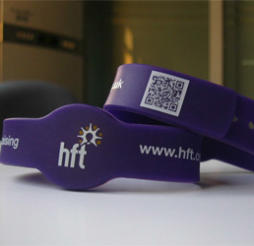A new wristband that will enable people to make faster donations with just a tap of a smartphone, is being tested by several leading charities.
National learning disabilities charity Hft and premature baby charity Bliss have already employed the new fundraising technology, with more charities due to start using the bands in the coming months.
The waterproof silicone band, created by the cloud-based mobile engagement company Wooshping, works by using a programmed chip that instantly connects smartphones to fundraising pages, to enable on-the-spot donations.
“We came up with the idea at the beginning of the year," said Rupert Englander, managing director of Wooshping. "The first charity to utilise the bands was Bliss. Since then, Hft have also started to use the bands and six to eight other charities are receiving their orders this week, including Southampton Hospital Charity and Rainforest Foundation UK.
"Further orders have also been placed by Crisis, Guide Dogs for the Blind, NCCA, Pancreatic Cancer Research Fund and the charity giving platform, Givey.”
The mobile technology used in the bands includes Near Field Communication (NFC) and QR codes. The donor simply taps their smartphone against the wristband or scans the QR code and will be taken directly to the selected donation page where they can input their card details.
The chips can also be programmed to direct people to multimedia content, creating a direct line of communication between donors and fundraisers.
Alaric Shorter, national projects manager for Bliss, said: “We’ve started giving the wristbands out to our fundraisers to try and tap into the rise of the mobile market and the increase in the number of smartphones containing Near Field Communication (NFC) technology.
“Using the wristband puts an end to people forgetting to donate to you, as you can get the donation straight away, easily, without having to make bank transfers or remember bank details. They make it easier to secure donations then and there at the moment of asking, and we’ve had a very good response to them from our supporters,” he said.
For Hft, the bands are a new way of meeting fundraising targets in tough economic times.
Chris Clarke, head of regional fundraising for Hft, said: “To be able to rise to the challenges of the demanding economic climate, it’s essential to embrace pioneering fundraising techniques like this, which both engage and suit the needs and lifestyles of those making the donations.”
Hft will use the technology to increase donations across a range of fundraising activities, including its portfolio of “Team Extreme” and “Challenge” events, such as bike rides, marathons and skydives.
With use of the wristbands in the early stages, the tap-and-go fundraising figures are still to be compiled.
“We don’t have any concrete data on donations made through the wristbands yet as it’s very early days,” said Englander. “Bliss only received their wristbands three weeks ago. But as a general premise, if someone who has one of these wristbands can raise one extra donation as a result of it, then it pays for itself and anything beyond it is an upside.”









